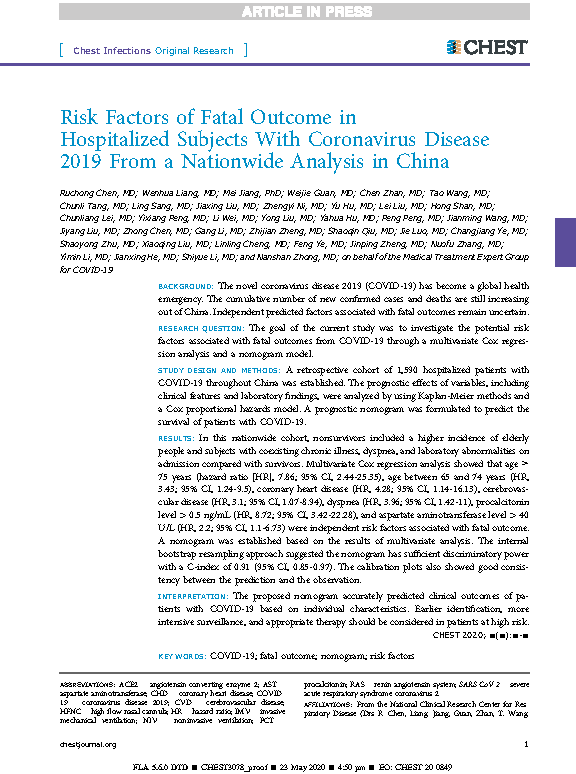16 June Risk Factors of Fatal Outcome in Hospitalized Subjects With Coronavirus Disease 2019 From a Nationwide Analysis in China
Ruchong Chen, Wenhua Liang, Mei Jiang, Weijie Guan, Chen Zhan, Tao Wang, Chunli Tang, Ling Sang, Jiaxing Liu, Zhengyi Ni, Yu Hu, Lei Liu, Hong Shan, Chunliang Lei, Yixiang Peng, Li Wei, Yong Liu , Yahua Hu, Peng Peng, Jianming Wang, Jiyang Liu, Zhong Chen, Gang Li, Zhijian Zheng, Shaoqin Qiu, Jie Luo, Changjiang Ye, Shaoyong Zhu, Xiaoqing Liu, Linling Cheng, Feng Ye, Jinping Zheng, Nuofu Zhang, Yimin Li, Jianxing He, Shiyue Li, and Nanshan Zhong, on behalf of the Medical Treatment Expert Group for COVID-19

ABSTRACT
Background:
The novel coronavirus disease 2019 (COVID-19) has become a global health emergency. The cumulative number of new confirmed cases and deaths continues to rise outside of China. Independent predicted factors associated with fatal outcomes remain uncertain.
Research question:
The aim of the present study was to investigate the potential risk of factors associated with fatal outcomes of COVID-19 through Cox multivariate regression analysis and a nomogram model.
Study design and methods:
Retrospective cohort of 1.590 hospitalized COVID-19 patients from across China. The prognostic effects of variables, including clinical features and laboratory findings, were analyzed using the Kaplan-Meier methods and the Cox proportional hazards model. A prognostic nomogram was formulated to predict the survival of patients with COVID-19.
Results:
In this nationwide cohort, non-survivors included a higher incidence of the elderly and patients with coexisting chronic illnesses, dyspnea, and laboratory abnormalities on admission compared with survivors. Cox multivariate regression analysis showed that age ≥75 years (hazard ratio [HR], 7.86; 95% CI, 2.44-25.35), age between 65 and 74 years (HR, 3,43; 95% CI, 1.24-9.5), coronary artery disease (HR, 4.28; 95% CI, 1.14-16.13), cerebrovascular disease (HR, 3.1; 95% CI, 1.07-8.94), dyspnea (HR, 3.96; 95% CI, 1.42-11 ), procalcitonin level > 0.5 ng/mL (HR, 8.72; 95% CI, 3.42-22.28), and aspartate aminotransferase level > 40 U/L (HR, 2.2; 95% CI, 1.1-6.73) were risk factors. independent risks associated with a fatal outcome.
A nomogram was established based on the results of the multivariate analysis. The internal sampling approach suggested that the nomogram has sufficient discriminatory power with a C-index of 0.91 (95% CI, 0.85-0.97). The calibration plots also showed good consistency between the prediction and the observation.
Interpretation:
The proposed nomogram accurately predicted the clinical outcomes of COVID-19 patients based on individual characteristics. Early identification, intensive surveillance, and appropriate therapy should be considered in high-risk patients.


